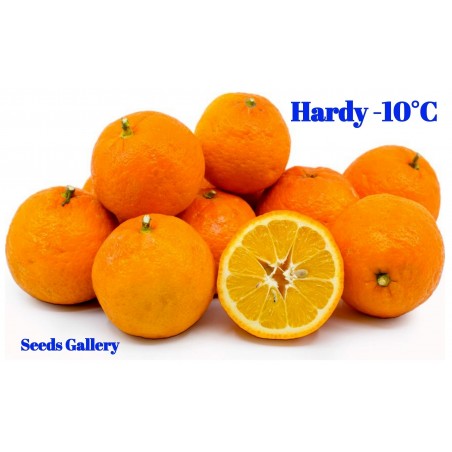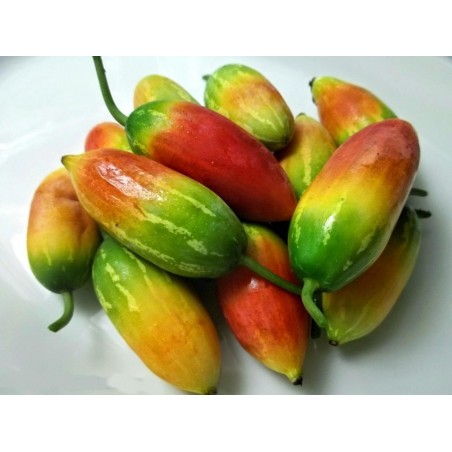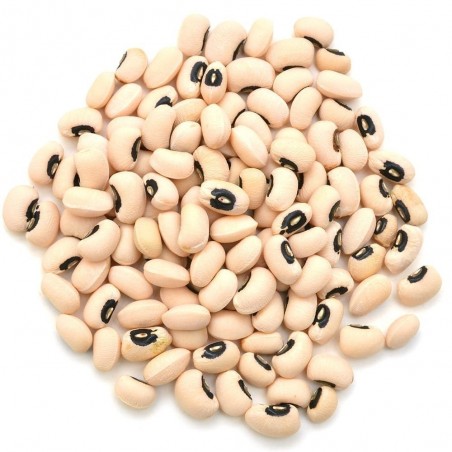
Ivy Gourd, Scarlet Gourd Seeds (Coccinia grandis)
Ivy Gourd, Scarlet Gourd Seeds (Coccinia grandis)
Price for Package of 5 seeds.
Coccinia grandis, the ivy gourd, also known as scarlet gourd and Kowai, is a tropical vine. In Southeast Asia, it is grown for its edible young shoots and edible fruits.
This plant is a perennial climber with single tendrils and glabrous leaves. The leaves have 5 lobes and are 6.5–8.5 cm long and 7–8 cm wide. Female and male flowers emerge at the axils on the petiole, and have 3 stamens.
Geographic spread
Its native range extends from Africa to Asia, including India, the Philippines, Cambodia, China, Indonesia, Malaysia, Myanmar, Thailand, Vietnam, eastern Papua New Guinea, and the Northern Territories, Australia. Its documented introduced range includes the Federated States of Micronesia, Fiji, Guam, Saipan, Hawaii, the Marshall Islands, Samoa, Tonga, and Vanuatu.
Seeds or fragments of the vine can be relocated and lead to viable offspring. This can occur when humans transport organic debris or equipment containing C. grandis. Once the ivy gourd is established, it is presumably spread by birds, rats, and other mammals. In Hawaii, the fruit may be dispersed by pigs.[4] Long-distance dispersal is most commonly carried out by humans due to its culinary uses or by mistake. Regarded as very invasive and on the Hawaii State Noxious Weed List, ivy gourd can grow up to four inches per day. It grows in dense blankets, shading other plants from sunlight and highjacking nutrients, effectively killing vegetation underneath.[5] It was introduced to Hawaii as a backyard food crop. It is sometimes tolerated along garden fences and other outdoor features because of its attractive white flowers. It has escaped to become a vigorous pest in Hawaii, Florida, Australia, and Texas.
Weed control
Both physical and chemical recommendations are made for control of the ivy gourd. It is very difficult to control this plant physically except by bagging fruits. Hand-harvesting normally does not kill the plant, but rather breaks the vine blankets into smaller pieces and the plant is able to re-establish when it touches the ground. These methods can make the infestation worse and further the need for more rigorous control methods. Picking the fruit and placing them in plastic bags can help decrease the seed bank present with the soil. When using chemical controls, that ivy gourd responded well to a thin-lined bark application of 100% Garlon 4 (triclopyr), leaving plants in place so as not to translocate the herbicide or spread the pest.[4] It is applied multiple times until the vine dies. In Hawaii, several species of insect have been introduced with the purpose of being a biocontrol. Two weevils, Acythopeus burkhartorum and A. cocciniae, were introduced by the Department of Agriculture to Oahu and Hawaii. African vine moths were also released onto Oahu and Maui. On the island of Maui, the A. cocciniae apparently is established and damaging leaves. The larvae feed on the plant and the adults chew holes in the leaves. The moth has yet to appear successful in its purpose.
Medicinal value
In traditional medicine, fruits have been used to treat leprosy, fever, asthma, bronchitis, and jaundice. The fruit possesses mast cell-stabilizing, antianaphylactic, and antihistaminic potential. In Bangladesh, the roots are used to treat osteoarthritis and joint pain. A paste made of leaves is applied to the skin to treat scabies.
Ivy gourd extracts and other forms of the plant can be purchased online and in health food stores. These products are claimed to help regulate blood sugar levels. Some research supports that compounds in the plant inhibit glucose-6-phosphatase.[9] Glucose-6-phosphatase is one of the key liver enzymes involved in regulating sugar metabolism. Therefore, ivy gourd is sometimes recommended for diabetic patients. Although these claims have not been supported, a fair amount of research on the medicinal properties of this plant are focusing on its use as an antioxidant, antihypoglycemic agent, immune system modulator, etc. Some countries in Asia, such as Thailand, prepare traditional tonic-like drinks for medicinal purposes.
Recipes
A variety of recipes from all over the world list rashmato, the fruit, as the main ingredient. They are best when cooked, and are often compared to bitter melon. The fruit is commonly eaten in Indian cuisine. People of Indonesia and other Southeast Asian countries also consume the fruit and leaves. In Thai cuisine, it is one of the ingredients of the very popular clear soup dish kaeng jued tum lueng [10] and some curries kaeng khae curry and kaeng lieng curry.[11] Cultivation of rashmati in home gardens has been encouraged in Thailand due to it being a good source of several micronutrients, including vitamins A and C.
In India, it is eaten as a curry, by deep-frying it along with spices, stuffing it with masala and sauteing it, or boiling it first in a pressure cooker and then frying it. It is also used in sambar, a vegetable and lentil-based soup.
Nutrition
Ivy gourd is rich in beta-carotene.
| HEIRLOOM ? | Yes |
|---|---|
| Organic Seeds ? | Organic Seeds |
| Edible ? | Edible |
| Life Cycle: | Perennial plant : Yes |
| Handpicked seeds ? | Handpicked seeds |
| Medicinal Plant ? | Medicinal Plant: Yes |


Your review appreciation cannot be sent
Report comment
Report sent
Your report cannot be sent
Write your review
Review sent
Your review cannot be sent
🌍 Worldwide Shipping from the EU
We ship worldwide from the European Union using registered air post with signature confirmation on delivery.
📦 Tracking Your Order
Log in to your account and go to Order History > Details to find your tracking number.
You will receive email notifications at every step — please check your spam/junk folder if you don’t see them.
Track your package via:
⚠️ Important Notices
Cash on delivery is not available.
Always provide a valid mobile number with country code when ordering (e.g., +365 456 7686 576).
Do not order to P.O. Boxes or if you cannot be home to sign for the package. We cannot leave parcels with neighbors.
If a package sent to a P.O. Box is lost or undelivered, you lose the right to a refund.
📦 Lost, Returned & Reshipping Packages
For customers in Brazil and Mexico:
We cannot refund packages lost or destroyed by customs.
If your package is returned, we will refund only the product cost — shipping costs are not refundable.
You must pay return postage (€2) and any costs for reshipping.
If a package is returned to us for any reason, you are responsible for paying the return shipping (€2) plus the cost to resend the package.
🚚 Shipment Delivery
Registered shipments require a signature from the recipient.
If your tracking shows the package is still at the origin post office, it means the package is in transit — please contact your local post office directly for updates.
We are not responsible for delivery times and cannot track shipments for you.
📅 Delivery Options & Estimated Times
Delivery Option Processing Time Notes Priority Delivery Ships in 1-7 business days Prioritizes order processing (not guaranteed faster delivery); delays possible during holidays (3-10 days) Secured Delivery Ships in 1-7 business days Available for orders up to €150; refund if lost Standard Delivery Ships in 7-10 business days More economical; delays possible during holidays (7-14 days) Estimated Delivery Time:
Within the EU: 3–20 days
Worldwide: 5–30 days
Example delivery times to the USA:
Delivered in 13, 17, 19, 22, or 27 days.Note: Delivery times depend on your location and the local postal system. COVID-19 may cause additional delays.
💰 Shipping Costs
Shipping and handling fees are calculated automatically during checkout based on the weight of the parcel and the destination country.
⏰ Order Processing Hours
We do not process or ship orders on Saturdays or Sundays.
💳 Payment Options
Bank Transfer (SEPA / IBAN / SWIFT-BIC)
Include your order reference in the payment description (e.g., "SGS-19811702"). Orders without payment within 7 days are automatically cancelled.PayPal
Payments accepted in Euros only. Please select Euros at checkout.Card Payment
For card payments, visit our other site: Exotic Seeds Store
We accept Visa, MasterCard, American Express, CB, Diners Club, Discover, China UnionPay, JCB, and Discover.
⚠️ Transaction Fees
Customers are responsible for any transaction fees. Please provide payment details to help us process your order efficiently.
📢 Final Notes
Before placing your order, please check our website for any special notices, holiday schedules, or specific conditions that may affect your purchase.
Related Products

























